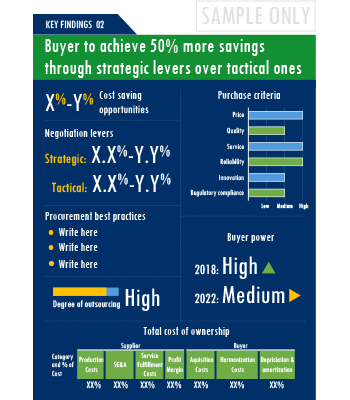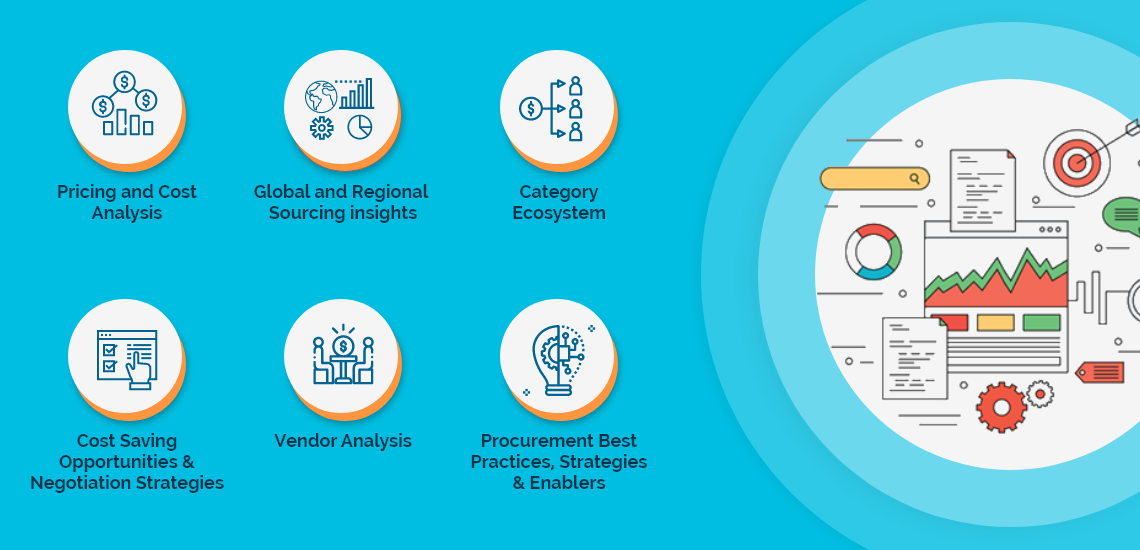A complete buyer's guide that provides comprehensive insights on Load Balancing Software category spend, spend growth and regional segmentation; in-depth price trends; negotiation levers and analysis of Load Balancing Software suppliers.
GET FREE SAMPLEEcosystem of the global Load Balancing Software category is intertwined with the larger parent market of End User Software and Hardware. Our category definition describes that overall End User Software and Hardware market includes all spend relating to the provision of off the shelf software, computer equipment, components, upgradation and replacement.
The market for End User Software and Hardware and its sub-segments such as Load Balancing Software are at an interesting intersection. Rise in the cost of certain essential assets and supplies required to deliver Load Balancing Software is making a significant addition to the supplier's overall expenditure. This could have an inflationary impact on buyer's procurement expenditure in the Load Balancing Software market.In a bid to differentiate themselves in an overcrowded technology space, suppliers are now focusing on creating industry-specific specialized products. Buyers see this trend as an opportunity to procure more targeted solutions and are developing internal capabilities to identify and leverage innovations in the supplier base.Global market is facing a shortage of professionals with requisite skills and training. Minimum wages and stringent regulations are compelling suppliers to increase their employee expenses which are expected to have an inflationary impact on buyer's procurement cost.Trends like these and many others discussed in this report are necessitating a relook at the way Load Balancing Software is procured and the procurement cost saving opportunities that exist.
As market conditions become more dynamic and procurement practices get more sophisticated, category managers need to be cognizant of the best practices that work for their Load Balancing Software category procurement. The report offers a succinct analysis of Load Balancing Software procurement best practices. For example, Transferring to a new supplier can be often costly and can further get exacerbated by instances of vendor lock-ins. Buyers must scrutinize the offerings of service providers for any possibilities of vendor lock-ins and demand client testimonials from service providers to assess such possibilities. Watch out for products/services that are priced excessively low, as they can often result in costly lock-ins. Buyers must clearly define clauses pertaining to the ownership of subcontracting services that are not a part of preferred suppliers' portfolios. Subcontractors should be bound by the same terms and conditions as the main contractor to ensure consistency in quality and manage any adverse event such as data breach. Category managers must explore opportunities to integrate planning and management activities using analytics to gain better control over category spend. This will also allow them to consolidate supply base easily as well as segment service providers depending on requirements and spend on each service provider.
Activate your free account to gain easy access to cutting edge research and insights on consumers, emerging price trends, global and regional suppliers.
Load Balancing Software procurement managers also need to proactively identify and mitigate potential risks that can arise in the supply chain or contracts for Load Balancing Software procurement. Some examples include:
For detailed insights and complete access to our report library, activate your free account!
The report is intended to serve as a one-stop reference guide for Load Balancing Software procurement strategy and offers a perfect blend of category basics with deep-dive category data and insights. Therefore, it is ideal for category beginners looking for “Load Balancing Software: Procurement Report 101” as well as for category experts actively tracking the global Load Balancing Software procurement market.
You may have just initiated your research to design a winning Load Balancing Software procurement strategy, or you may be a category expert looking for strategic insights and updated data.Either ways, the report has your requirements covered.

Unlock SpendEdge's comprehensive procurement report collection with ease through our procurement platform.
Procurement decisions can prove to be costly in the absence of careful deliberation and evaluation of every available option. In fact, more than 90% of the decision makers we work with acknowledge that timely availability of up-to-date category intelligence can help them make better purchasing decisions. More than 80% of them believe that in-house category intelligence needs to be updated periodically to achieve full benefits. If you have read so far, we are quite sure you agree!!
The Load Balancing Software procurement report helps take more informed decisions by placing all the critical information and advice at the fingertips of a decision maker. It also specifically answers some of the key questions that we have been routinely asked during our industry outreach initiatives:
SpendEdge Insights has helped procurement professionals and sourcing teams manage multiple spend areas and achieve more than $2 billion in savings. Activate your free account today!
The Load Balancing Software market report offers a complete picture of the supply market and analyzes the category from the perspective of both buyers and suppliers. Analysis of the category trends, procurement best practices, negotiation levers and overall category management strategy advisory are interspersed with in-depth data and commentary on spend outlook, pricing ecosystem and supplier landscape drilled down to a region-level coverage.

A key highlight of this report is the in-depth outlook created on Load Balancing Software procurement spend and pricing trends. The report further delves deep into the aspects of cost structure, total cost of ownership and supplier margins for Load Balancing Software. A dedicated section to supplier profiles and evaluation helps decision makers cast a wider procurement net and identify gaps in existing relationships.

Along with specific category and supplier intelligence, the publication also includes curated insights on Load Balancing Software market trends, price influencers and inherent risks. These insights help the decision makers prepare for market shaping trends in advance and create alternative strategies for changes in the market conditions.

Additionally, the report also advises on the best practices and strategies to manage the Load Balancing Software category efficiently. Negotiation levers and opportunities are explained in detail along with quantification of their potential. Benchmark KPIs for supplier and buyer performance management are also aggregated to better organize the category objectives. Other themes of advisory include ideal procurement organization structure, enablers to achieve KPIs or category objectives and ideal SLAs to have with suppliers.






Our research is complex, but our reports are easy to digest. Quantitative analysis and exhaustive commentary is placed in an easy to read format that gives you an in-depth knowledge on the category without spending hours to figure out “what does it mean for my company?”


SpendEdge presents a detailed picture of Load Balancing Software procurement solutions by way of study, synthesis, and summation of data from multiple sources. The analysts have presented the various facets of the market with a particular focus on identifying the key category influencers. The data thus presented is comprehensive, reliable, and the result of extensive research, both primary and secondary.

Global Data Masking Software Market - Procurement Intelligence Report

Global Asset Tracking Software Market - Procurement Intelligence Report

Global Implementation of CRM/ETMS Application Market - Procurement Intelligence Report

Global Issue Tracking Software Market - Procurement Intelligence Report

Global Website Analytics Software Market - Procurement Intelligence Report

Global Lease Management Software Market - Procurement Intelligence Report

Global Maintenance Management Software Market - Procurement Intelligence Report

Global Enterprise Mobility Management Software Market - Procurement Intelligence Report

Global Digital Asset Management Software Market - Procurement Intelligence Report
Access this report and our entire procurement platform | Plans starting from USD 3000/ Year Buy Now
Copyright © 2026 Infiniti Research Limited. All Rights Reserved. Privacy Notice – Terms of Use – Sales and Subscription
Cookie Policy
The Site uses cookies to record users' preferences in relation to the functionality of accessibility. We, our Affiliates, and our Vendors may store and access cookies on a device, and process personal data including unique identifiers sent by a device, to personalise content, tailor, and report on advertising and to analyse our traffic. By clicking “I’m fine with this”, you are allowing the use of these cookies. You may change your settings based on a legitimate interest at any time, by selecting “Manage Settings” on our site. Please refer to the help guide of your browser for further information on cookies, including how to disable them. Review our Privacy & Cookie Notice.
